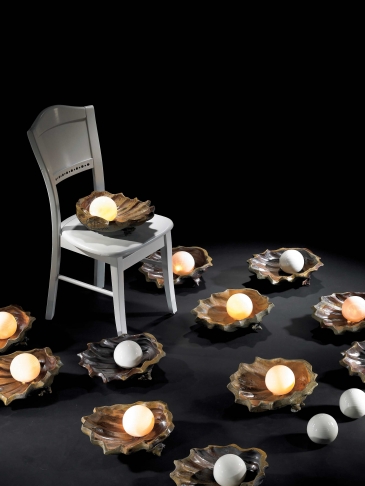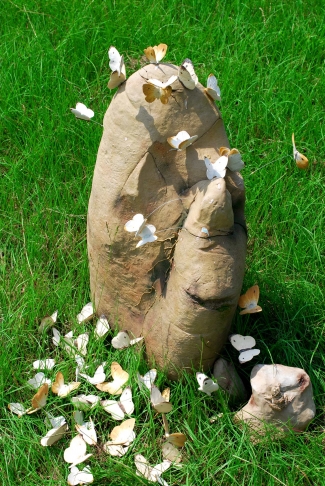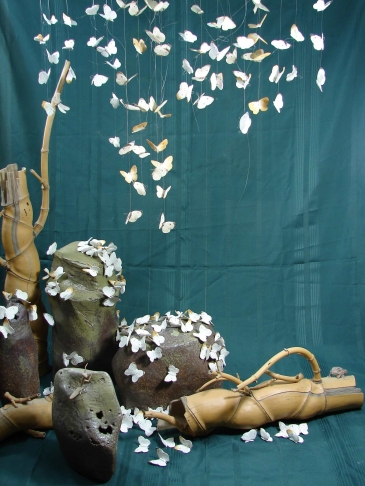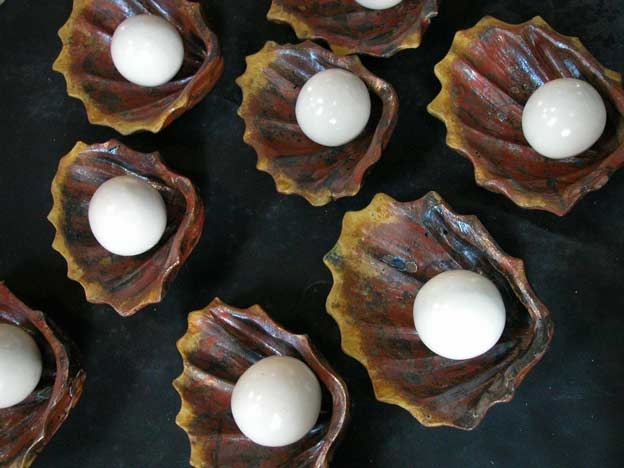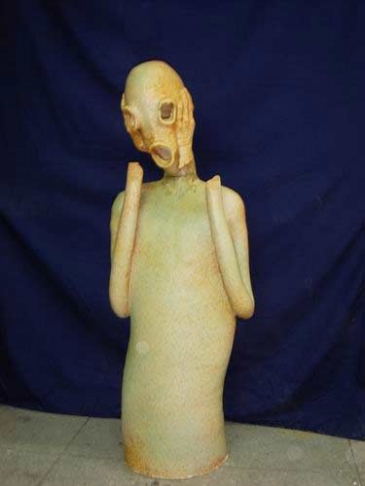Multiformited-Essence Space: Post-Ceramics 2007
2007.07.20~2007.09.02
09:00 - 17:00
Multiformited-Essence Space: Post-Ceramics 2007 Introduction For a long time, our cognition to ceramic art has always been associated with its practical and decorative functions. Trying to break this prejudice, Curator LI Tsuei-yu has dedicated herself on ceramic exhibitions since
Post-Ceramics I” in 2004 and
Post-Ceramics II”, 2005. From July 20, a new exhibition
Multiformed-Essence Space: Post Ceramics 2007” will be opened in the Kuandu Museum of Fine Arts. Participant artists include YU Cheng-chung, WU Shuei-yi, WU Wei-ku, TANG Jun-chin and LIEN Pao-tsai. As the exhibition’s Chinese title refers, the word
Po” could be translated as
break” and transliterated as
post”. The exhibition goal is to
break” the general definition and presents new styles of ceramic arts. Simultaneously, by using phrases
multiformed” and
space”, the title shows those participant artists have different styles, techniques, and concepts, and points out how exhibits echo with the space as well. In terms of techniques and concepts, TANG Jun-chin’s
The puzzlement on retina” is composed of thousands exquisite ceramic butterflies which were made in excellent skills, flying in Gallery 101 and the courtyard of the museum. These butterflies are decorated indoors and outdoors, which illustrates an ideal world where human and ecology exist together. In Gallery 103, YU Cheng-chung’s
New Talking Movement—Our Songs” series consist of various and bizarre human bodies and limbs. Big mouths attached on the works symbolize that how modern people rely on
talking”—everyone talks ceaselessly, and the
mouth” has displaced
heart” and
brain”, and played a much more important role. In Gallery 104, the shape of WU Wei-ku’s
Geometry.Relationship” series is quite concise and simple. The artist simplifies what the works narrate; yet the spine of the seam and the transformation of glazing colors unfold the power and energy of his works in an implicit way. WU Shuei-yi’s
Imaginations from Pearls on Sea Scallops”, similarly, reveals the power from the work itself. The artist puts pearls that made of mixed porcelain clay onto wood-firing sea scallops, and installs them on black floor and white table. He tries to make a contrast between colors and texture, and adds a bit mystery on these glimmered works. There is some resemblance in LIEN Pao-tsai’s
New Aesop’s Fables”. She leads the visitors step into a fantasyland, where frogs, cats, and mice have exaggerative and funny facial expressions. The artist employs the fables to sneer at human nature and lusts cleverly. The five artists, with different ceramic art background and style, reveal to us the possibility and future of ceramic art. The curator expects that this exhibition would
amplifies the power of ceramic art in the new age”. It is also our hope that it would open up a new way and new point of view in front of our visitors.
Post-Ceramics I” in 2004 and
Post-Ceramics II”, 2005. From July 20, a new exhibition
Multiformed-Essence Space: Post Ceramics 2007” will be opened in the Kuandu Museum of Fine Arts. Participant artists include YU Cheng-chung, WU Shuei-yi, WU Wei-ku, TANG Jun-chin and LIEN Pao-tsai. As the exhibition’s Chinese title refers, the word
Po” could be translated as
break” and transliterated as
post”. The exhibition goal is to
break” the general definition and presents new styles of ceramic arts. Simultaneously, by using phrases
multiformed” and
space”, the title shows those participant artists have different styles, techniques, and concepts, and points out how exhibits echo with the space as well. In terms of techniques and concepts, TANG Jun-chin’s
The puzzlement on retina” is composed of thousands exquisite ceramic butterflies which were made in excellent skills, flying in Gallery 101 and the courtyard of the museum. These butterflies are decorated indoors and outdoors, which illustrates an ideal world where human and ecology exist together. In Gallery 103, YU Cheng-chung’s
New Talking Movement—Our Songs” series consist of various and bizarre human bodies and limbs. Big mouths attached on the works symbolize that how modern people rely on
talking”—everyone talks ceaselessly, and the
mouth” has displaced
heart” and
brain”, and played a much more important role. In Gallery 104, the shape of WU Wei-ku’s
Geometry.Relationship” series is quite concise and simple. The artist simplifies what the works narrate; yet the spine of the seam and the transformation of glazing colors unfold the power and energy of his works in an implicit way. WU Shuei-yi’s
Imaginations from Pearls on Sea Scallops”, similarly, reveals the power from the work itself. The artist puts pearls that made of mixed porcelain clay onto wood-firing sea scallops, and installs them on black floor and white table. He tries to make a contrast between colors and texture, and adds a bit mystery on these glimmered works. There is some resemblance in LIEN Pao-tsai’s
New Aesop’s Fables”. She leads the visitors step into a fantasyland, where frogs, cats, and mice have exaggerative and funny facial expressions. The artist employs the fables to sneer at human nature and lusts cleverly. The five artists, with different ceramic art background and style, reveal to us the possibility and future of ceramic art. The curator expects that this exhibition would
amplifies the power of ceramic art in the new age”. It is also our hope that it would open up a new way and new point of view in front of our visitors.
Multiformited-Essence Space: Post-Ceramics 2007 Introduction For a long time, our cognition to ceramic art has always been associated with its practical and decorative functions. Trying to break this prejudice, Curator LI Tsuei-yu has dedicated herself on ceramic exhibitions since
Post-Ceramics I” in 2004 and
Post-Ceramics II”, 2005. From July 20, a new exhibition
Multiformed-Essence Space: Post Ceramics 2007” will be opened in the Kuandu Museum of Fine Arts. Participant artists include YU Cheng-chung, WU Shuei-yi, WU Wei-ku, TANG Jun-chin and LIEN Pao-tsai. As the exhibition’s Chinese title refers, the word
Po” could be translated as
break” and transliterated as
post”. The exhibition goal is to
break” the general definition and presents new styles of ceramic arts. Simultaneously, by using phrases
multiformed” and
space”, the title shows those participant artists have different styles, techniques, and concepts, and points out how exhibits echo with the space as well. In terms of techniques and concepts, TANG Jun-chin’s
The puzzlement on retina” is composed of thousands exquisite ceramic butterflies which were made in excellent skills, flying in Gallery 101 and the courtyard of the museum. These butterflies are decorated indoors and outdoors, which illustrates an ideal world where human and ecology exist together. In Gallery 103, YU Cheng-chung’s
New Talking Movement—Our Songs” series consist of various and bizarre human bodies and limbs. Big mouths attached on the works symbolize that how modern people rely on
talking”—everyone talks ceaselessly, and the
mouth” has displaced
heart” and
brain”, and played a much more important role. In Gallery 104, the shape of WU Wei-ku’s
Geometry.Relationship” series is quite concise and simple. The artist simplifies what the works narrate; yet the spine of the seam and the transformation of glazing colors unfold the power and energy of his works in an implicit way. WU Shuei-yi’s
Imaginations from Pearls on Sea Scallops”, similarly, reveals the power from the work itself. The artist puts pearls that made of mixed porcelain clay onto wood-firing sea scallops, and installs them on black floor and white table. He tries to make a contrast between colors and texture, and adds a bit mystery on these glimmered works. There is some resemblance in LIEN Pao-tsai’s
New Aesop’s Fables”. She leads the visitors step into a fantasyland, where frogs, cats, and mice have exaggerative and funny facial expressions. The artist employs the fables to sneer at human nature and lusts cleverly. The five artists, with different ceramic art background and style, reveal to us the possibility and future of ceramic art. The curator expects that this exhibition would
amplifies the power of ceramic art in the new age”. It is also our hope that it would open up a new way and new point of view in front of our visitors.
Post-Ceramics I” in 2004 and
Post-Ceramics II”, 2005. From July 20, a new exhibition
Multiformed-Essence Space: Post Ceramics 2007” will be opened in the Kuandu Museum of Fine Arts. Participant artists include YU Cheng-chung, WU Shuei-yi, WU Wei-ku, TANG Jun-chin and LIEN Pao-tsai. As the exhibition’s Chinese title refers, the word
Po” could be translated as
break” and transliterated as
post”. The exhibition goal is to
break” the general definition and presents new styles of ceramic arts. Simultaneously, by using phrases
multiformed” and
space”, the title shows those participant artists have different styles, techniques, and concepts, and points out how exhibits echo with the space as well. In terms of techniques and concepts, TANG Jun-chin’s
The puzzlement on retina” is composed of thousands exquisite ceramic butterflies which were made in excellent skills, flying in Gallery 101 and the courtyard of the museum. These butterflies are decorated indoors and outdoors, which illustrates an ideal world where human and ecology exist together. In Gallery 103, YU Cheng-chung’s
New Talking Movement—Our Songs” series consist of various and bizarre human bodies and limbs. Big mouths attached on the works symbolize that how modern people rely on
talking”—everyone talks ceaselessly, and the
mouth” has displaced
heart” and
brain”, and played a much more important role. In Gallery 104, the shape of WU Wei-ku’s
Geometry.Relationship” series is quite concise and simple. The artist simplifies what the works narrate; yet the spine of the seam and the transformation of glazing colors unfold the power and energy of his works in an implicit way. WU Shuei-yi’s
Imaginations from Pearls on Sea Scallops”, similarly, reveals the power from the work itself. The artist puts pearls that made of mixed porcelain clay onto wood-firing sea scallops, and installs them on black floor and white table. He tries to make a contrast between colors and texture, and adds a bit mystery on these glimmered works. There is some resemblance in LIEN Pao-tsai’s
New Aesop’s Fables”. She leads the visitors step into a fantasyland, where frogs, cats, and mice have exaggerative and funny facial expressions. The artist employs the fables to sneer at human nature and lusts cleverly. The five artists, with different ceramic art background and style, reveal to us the possibility and future of ceramic art. The curator expects that this exhibition would
amplifies the power of ceramic art in the new age”. It is also our hope that it would open up a new way and new point of view in front of our visitors.
